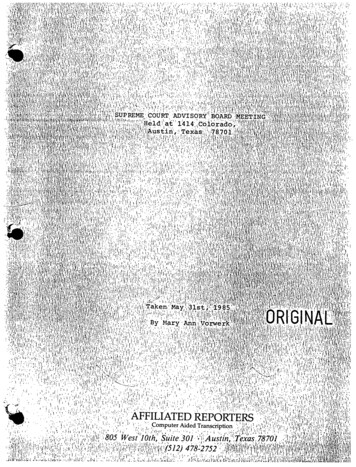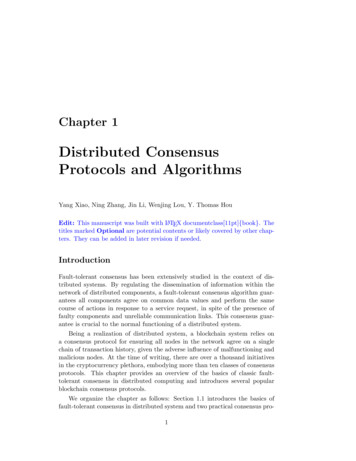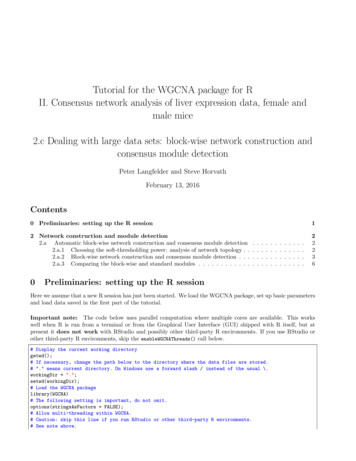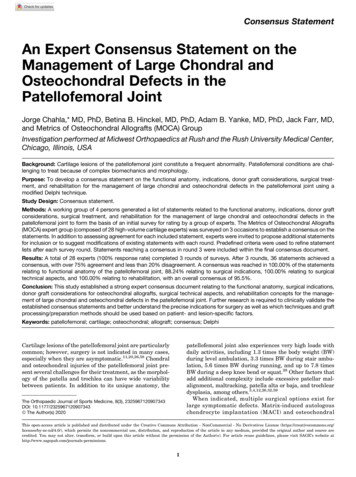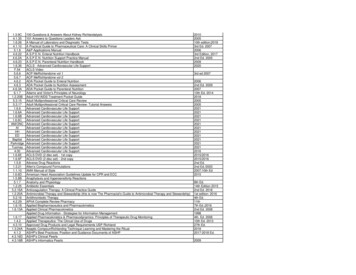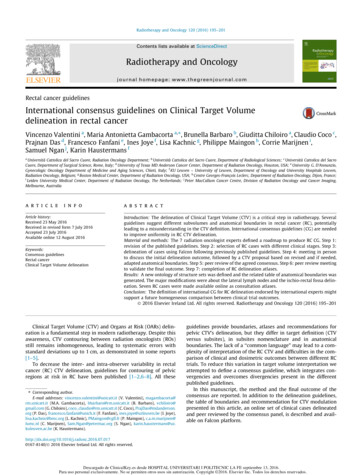
Transcription
Radiotherapy and Oncology 120 (2016) 195–201Contents lists available at ScienceDirectRadiotherapy and Oncologyjournal homepage: www.thegreenjournal.comRectal cancer guidelinesInternational consensus guidelines on Clinical Target Volumedelineation in rectal cancerVincenzo Valentini a, Maria Antonietta Gambacorta a, , Brunella Barbaro b, Giuditta Chiloiro a, Claudio Coco c,Prajnan Das d, Francesco Fanfani e, Ines Joye f, Lisa Kachnic g, Philippe Maingon h, Corrie Marijnen i,Samuel Ngan j, Karin Haustermans faUniversità Cattolica del Sacro Cuore, Radiation Oncology Department; b Università Cattolica del Sacro Cuore, Department of Radiological Sciences; c Università Cattolica del SacroCuore, Department of Surgical Science, Rome, Italy; d University of Texas MD Anderson Cancer Center, Department of Radiation Oncology, Houston, USA; e University G. D’Annunzio,Gynecologic Oncology Department of Medicine and Aging Sciences, Chieti, Italy; f KU Leuven – University of Leuven, Department of Oncology and University Hospitals Leuven,Radiation Oncology, Belgium; g Boston Medical Center, Department of Radiation Oncology, USA; h Centre Georges-François Leclerc, Department of Radiation Oncology, Dijon, France;iLeiden University Medical Center, Department of Radiation Oncology, The Netherlands; j Peter MacCallum Cancer Centre, Division of Radiation Oncology and Cancer Imaging,Melbourne, Australiaa r t i c l ei n f oArticle history:Received 23 May 2016Received in revised form 7 July 2016Accepted 23 July 2016Available online 12 August 2016Keywords:Consensus guidelinesRectal cancerClinical Target Volume delineationa b s t r a c tIntroduction: The delineation of Clinical Target Volume (CTV) is a critical step in radiotherapy. Severalguidelines suggest different subvolumes and anatomical boundaries in rectal cancer (RC), potentiallyleading to a misunderstanding in the CTV definition. International consensus guidelines (CG) are neededto improve uniformity in RC CTV delineation.Material and methods: The 7 radiation oncologist experts defined a roadmap to produce RC CG. Step 1:revision of the published guidelines. Step 2: selection of RC cases with different clinical stages. Step 3:delineation of cases using Falcon following previously published guidelines. Step 4: meeting in personto discuss the initial delineation outcome, followed by a CTV proposal based on revised and if needed,adapted anatomical boundaries. Step 5: peer review of the agreed consensus. Step 6: peer review meetingto validate the final outcome. Step 7: completion of RC delineation atlases.Results: A new ontology of structure sets was defined and the related table of anatomical boundaries wasgenerated. The major modifications were about the lateral lymph nodes and the ischio-rectal fossa delineation. Seven RC cases were made available online as consultation atlases.Conclusion: The definition of international CG for RC delineation endorsed by international experts mightsupport a future homogeneous comparison between clinical trial outcomes.Ó 2016 Elsevier Ireland Ltd. All rights reserved. Radiotherapy and Oncology 120 (2016) 195–201Clinical Target Volume (CTV) and Organs at Risk (OARs) delineation is a fundamental step in modern radiotherapy. Despite thisawareness, CTV contouring between radiation oncologists (ROs)still remains inhomogeneous, leading to systematic errors withstandard deviations up to 1 cm, as demonstrated in some reports[1–5].To decrease the inter- and intra-observer variability in rectalcancer (RC) CTV delineation, guidelines for contouring of pelvicregions at risk in RC have been published [1–2,6–8]. All these Corresponding author.E-mail addresses: vincenzo.valentini@unicatt.it (V. Valentini), magambacorta@rm.unicatt.it (M.A. Gambacorta), bbarbaro@rm.unicatt.it (B. Barbaro), vchiloiro@gmail.com (G. Chiloiro), coco claudio@rm.unicatt.it (C. Coco), PrajDas@mdanderson.org (P. Das), francesco.fanfani@unich.it (F. Fanfani), ines.joye@uzleuven.be (I. Joye),lisa.kachnic@bmc.org (L. Kachnic), PMaingon@cgfl.fr (P. Maingon), c.a.m.marijnen@lumc.nl (C. Marijnen), Sam.Ngan@petermac.org (S. Ngan), karin.haustermans@uz.kuleuven.ac.be (K. Haustermans).guidelines provide boundaries, atlases and recommendations forpelvic CTV’s delineation, but they differ in target definition (CTVversus subsites), in subsites nomenclature and in anatomicalboundaries. The lack of a ‘‘common language” may lead to a complexity of interpretation of the RC CTV and difficulties in the comparison of clinical and dosimetric outcomes between different RCtrials. To reduce this variation in target volume interpretation weattempted to define a consensus guideline, which integrates convergencies and overcomes divergencies present in the differentpublished guidelines.In this manuscript, the method and the final outcome of theconsensus are reported. In addition to the delineation guidelines,the table of boundaries and recommendation for CTV modulationpresented in this article, an online set of clinical cases delineatedand peer reviewed by the consensus panel, is described and available on Falcon 7.0170167-8140/Ó 2016 Elsevier Ireland Ltd. All rights reserved.Descargado de ClinicalKey.es desde HOSPITAL UNIVERSITARI I POLITECNIC LA FE septiembre 13, 2016.Para uso personal exclusivamente. No se permiten otros usos sin autorización. Copyright 2016. Elsevier Inc. Todos los derechos reservados.
196Consensus delineation guidelines in rectal cancerMaterials and methodsResultsParticipantsConsensus was obtained for delineation of the CTV for electiveirradiation of all regional lymph node levels. Seven subsites at riskwere identified: presacral space (PS), mesorectum (M), laterallymph nodes (LLN), external iliac nodes (EIN), inguinal nodes(IN), ischiorectal fossa (IRF) and sphincter complex (SC).A working group (WG) of seven skilled ROs, reviewed the current guidelines and proposed consensus guidelines for RC CTVdelineation. All ROs were authors of at least one of the publisheddelineation guidelines and all of them were members of the principal radiation oncology societies: the European Society of Radiotherapy & Oncology (ESTRO), the American Society for RadiationOncology (ASTRO), the Trans Tasman Radiation Oncology Group(TROG) and the European Organization for Research and Treatmentof Cancer (EORTC).Surgeons and radiologists specialized in RC and gynecologicalcancer were involved in the discussion of the anatomical boundaries of the different CTV subsites. The working group focused onthe definition and delineation of the elective nodal CTV. Delineation of the gross tumor volume (GTV) was beyond the scope ofthis project.Falcon, the educational web-based multifunctional platform fordelineation endorsed by ESTRO, was used to support the consensusprocess and to facilitate the validation process by teleconferencediscussions.Consensus processDuring a kick-off meeting, the seven delegates defined a roadmap to develop consensus guidelines on RC CTV delineation.Following steps of the process were defined: Step 1: comparison of the current and available publishedguidelines. Step 2: selection of RC cases with different clinical stages andtumor location for delineation agreement exercises on theFalcon platform. Step 3: selection of CT scan slices considered significant interms of potential disagreement for each case and delineationof RC cases following previously published guidelines. Step 4: meeting to discuss the results of the first delineationround, followed by a CTV proposal based on new anatomicalboundaries. During this meeting, the pelvic anatomy wasreviewed with the aid of a surgeon and a radiologist, bothexperts in rectal and gynecological cancer. Step 5: peer review of the agreed consensus. Step 6: meeting to validate the final consensus guidelines. Step 7: completion of RC delineation atlases for publication onthe Falcon platform.The degree of agreement on RC CTV delineation among theseven observers was evaluated through the EduCause TMSTAPLEalgorithm.TimeframeA kick-off meeting was held in August 2014. Step 1 was at theASTRO meeting 2014: an overview of RC structure sets was made.In Table 1 provides an overview of the subsites defined in the available RC delineation guidelines. Details on their individual boundaries can be found in the Supplementary material. In December2014, seven rectal cancer cases were selected (Step 2). Step 3required 2 months to enable each participant to delineate theselected CT scan slices on Falcon. In April 2015, a meeting wasorganized in Rome and an agreement on subsites, anatomicalboundaries and CTV definition according to stage and tumor location was achieved (Step 4) (Table 2). In the following months, fourof the delegates completed Step 5: delineation of the CT slicesaccording to the new guidelines, and in July 2015 the other threedelegates reviewed them. During the ASTRO meeting held inSeptember 2015 a general consensus was reached (Step 6) andthree months later, seven atlases illustrating the delineation forthe different clinical stages at presentation were published onFalcon (Step 7). The entire process to develop final consensusguidelines, a table of boundaries and delineation atlases took17 months.Subsite boundariesConsensus boundaries are provided as Table 2 and Supplementary material. The following subsites were identified: Presacralnodes (PN), Mesorectum (M), Lateral lymph nodes (LLN), Externaliliac nodes (EIN), Ischio-rectal fossa (IRF), Sphincter complex (SC),Inguinal Nodes (IN).Presacral nodes (PN): PN are lymph nodes located within a thinspace between the rectum and the sacrum. We suggest to dividethis space into two sub-volumes: the abdominal and the pelvicPN. The abdominal PN start at the bifurcation of the aorta or5 mm above the positive node and end at the sacral promontory.At the level of the sacral promontory, the pelvic PN start, endingat the level of the caudal border of the M. Since the PN is a thinstructure, which is often difficult to identify on CT scan as a separate structure, the WG suggests to enclose this subsite in the M andthe LLN when the PN are at the level of these two structures.Mesorectum (M): The M is the fat around the rectum, boundedby the mesorectal fascia (MRF). In the mid-low pelvis, the M isTable 1overview of different subsites described in the available guidelines.NameSubsiteFuller CD1Valentini V2Roels S8Ng M6PSMLLNIINONEINIRF/IPSPresacral space (PS)Mesorectum (M)Lateral Lymph Nodes (LLN)Internal Iliac Nodes (IIN)Obturator Nodes (ON)External Iliac Nodes (EIN)Ischiorectal Fossa (IRF)Inferior Pelvic Subsite (IPS)CTV ACTV BCTV CXXXXXXXXXXXXXXXXCTV ACTV BCTV CXMyerson RJ7XXXXDescargado de ClinicalKey.es desde HOSPITAL UNIVERSITARI I POLITECNIC LA FE septiembre 13, 2016.Para uso personal exclusivamente. No se permiten otros usos sin autorización. Copyright 2016. Elsevier Inc. Todos los derechos reservados.XXX
197V. Valentini et al. / Radiotherapy and Oncology 120 (2016) 195–201Table 2Definition of subsites: anatomical boundaries and clinical ominalCranial: bifurcation of the aorta in common iliac arteries or 5 mmabove the most cranial positive lymph-nodeCaudal: sacral promontoryAnterior: 1 cm ventral to the lumbar vertebraePosterior: anterior wall of the lumbar vertebraeMedial: –Lateral: lateral surface of the common iliac vesselsCranial: bifurcation of the common iliac arteries into the external andinternal iliac artery/sacral promontoryCaudal: caudal border of the MAnterior: 1 cm ventral to the lumbar vertebraePosterior: anterior wall of the lumbar vertebraeMedial: –Lateral: sacroiliac jointsCranial: bifurcation of the IMA in SA and SRACaudal: insertion of the levator ani muscle into the external sphinctermuscles (disappearing of the mesorectal fat around the rectum)AnteriorSuperior: 7 mm beyond SRA excluding bowel structuresMid/inferior: mesorectal fascia, posterior border of the anterior pelvicorgansPosterior: Anterior surface of the sacrum and coccyx to the level of IRF(including the medial part of the PS)Medial: –Lateral:Upper/mid: Mesorectal fascia if visible or medial border of the LLN andEINLower: medial edge levator ani muscleCranial: Bifurcation of common iliac artery into internal and externaliliac arteriesCaudal: insertion of the levator ani muscle into the external sphinctermuscles (pelvic floor)AnteriorUpper pelvis: 7 mm around the vessel.Mid pelvis: a virtual coronal plane crossing the anterior wall of theureters when they join the bladder and the posterior aspect of theexternal iliac vessels craniallyInferior pelvis: posterior limit of the obturator fossaPosterior: Lateral edge of the sacro-iliac jointMedial:Upper: Above the M add 7 mm around the vessel, excluding normalanatomic structuresMid/lower: Mesorectal fascia, pelvic organsLateralUpper: iliopsoas, pelvic bonesMid-lower: medial edge of the pelvic wall muscles (pyriform andinternal obturator muscles)AnteriorMid pelvis: posterior wall of the EINLow pelvis (when external iliac vessels leave the pelvis): anteriorsurface of obturator arteryCranial: bifurcation of common iliac artery into internal and externaliliac arteriesCaudal: where the deep circumflex vein crosses the external iliacartery. Alternatively (if difficult detection on CT images) between theacetabulum roof and the superior pubic ramiAnterior: 0.7 cm anterior to the vessels. 1.5 cm antero-laterally alongthe iliopsoas muscle to include the antero-lateral nodesPosterior: posterior border of the external iliac veinMedial: 7 mm medial to the vessel, excluding pelvic organsLateral: the iliopsoas muscleCranial: where the deep circumflex vein crosses the external iliacartery. Alternatively (if difficult detection on CT images) between theacetabulum roof and the superior pubic ramiCaudal: where the great saphenous vein enters the femoral veinAnterior: at least 20 mm margin around inguinal vessels including anyvisible lymph nodes or lymphocelesPosterior: the femoral triangle formed by iliopsoas, pectineus andabductor longus musclesMedial: 10-20 mm margin around the femoral vessels including anyvisible lymph nodes or lymphocelesLateral: medial edge of the sartorius or iliopsoas musclesCranial: where the inferior pudendal artery leaves the pelvis (ischialtuberosity, internal obturator muscle, gluteus maximus muscle)Include it in case of positive lymph nodes.PelvicMLLNPosterior (exinternal iliacnodes)Anterior (exobturatornodes)EININIRF(1) This is a virtual space that in the current GL is included in thedelineation of M and LLN subsites, when the PS is at the level ofthese 2 structures. In all other cases the PS must be contouredseparately(2) Neuroforamina should not be included, unless there is directtumoral infiltration or close proximity of the tumorConsider anisotropic CTV-PTV margins anteriorly to account forbladder/uterus movementCranial limit:(1) In cT3N0, MRF , the cranial limit may be lowered at the levelof the bifurcation of the inferior mesenteric artery in sigmoidartery and superior rectal artery (corresponding to the craniallimit of the M)(2) In all other cases (MRF or cT4 or N ) consider the anatomicallimit of the bifurcation of the common iliac arteries in to internal iliac and external iliac arteries (corresponding to the craniallimit of the LLN)Include in case of:(1) positive nodes in the posterior LLN (internal iliac)(2) cT4(3) numerous mesorectal nodes (cN2)Include in case of:(1) cT4 tumors(2) positive anterior LLN (ex obturator)Include in case of:(1) positive IN(2) anal canal/external anal sphincter infiltration(3) in cT4 with infiltration of the lower third of the vaginaInclude when there is infiltration of the external anal sphincter or theischio-rectal fossa(continued on next page)Descargado de ClinicalKey.es desde HOSPITAL UNIVERSITARI I POLITECNIC LA FE septiembre 13, 2016.Para uso personal exclusivamente. No se permiten otros usos sin autorización. Copyright 2016. Elsevier Inc. Todos los derechos reservados.
198Consensus delineation guidelines in rectal cancerTable 2 (continued)SubsitesSCLimitsRecommendationsCaudal: oblique plane joining the inferior level of SC and the ischialtuberosity.Posterior:Mid-superior: major gluteus muscleInferior: a virtual line tangent to the posterior level of the sphincterMedial: levator ani muscleLateral: ischial tuberosity, internal obturator muscle, Gluteus maximusmuscleFrom the anal-rectal junction. Around the sphincterTo include in case of sphincter infiltrationPS: Presacral space, M: Mesorectum, LLN: Lateral Lymph Nodes, EIN: External Iliac Nodes, IN: Inguinal Nodes, IRF: Ischio-Rectal Fossae, SC: Sphincter Complex, IMA: inferiormesenteric artery, SA: sigmoid artery, SRA: superior rectal artery.anteriorly bound by the MRF and by the posterior border of theanterior pelvic organs (prostate, seminal vesicles, bladder andpenis bulb in men and vagina and uterus in women). An anterioranisotropic internal margin is recommended to account for bladder, uterus and seminal vesicles motion and/or volume variation[6,9]. This subsite is posteriorly bounded by the anterior surfaceof the sacrum. The WG suggests to include the medial part of PNinto the M.Lateral lymph nodes (LLN): The LLN correlate with a triangularlymph-vascular area located between the pelvic wall and the M,containing the lymphatic vessels and the nodes along the internaliliac and obturator vessels [8]. In the present guidelines this subsite has been divided into two sub-volumes: the posterior andthe anterior lateral nodes. The posterior lateral nodes have as anterior border a virtual coronal plane crossing the anterior wall of theureters when they join the bladder and the posterior aspect of theexternal iliac vessels cranially (Fig. 1). The anterior lateral nodeshave as the anterior border the posterior wall of the external iliacvessels lying anteriorly to the virtual coronal plane crossing theanterior wall of the ureters when it joins the bladder, till externaliliac vessels leave the pelvis.External iliac nodes (EIN): EIN are located around the externaliliac vessels. The cranial boundary corresponds to the upper limitof LLN. This region extends caudally to the level of the acetabulumroof and of the superior pubic rami where the deep circumflex veincrosses the external iliac artery (Fig. 2). For the antero-lateralboundary, in the upper pelvis a 7 mm margin should be consideredaround the external iliac vessels, while in the mid-low pelvis wesuggest to take a 15 mm margin, along the ilio-psoas muscle [10].Ischio-rectal fossa (IRF): IRF is the fatty triangular area formedbetween the framed by the levator ani muscles, the obturatorand gluteus muscles and the ischial tuberosity. It starts wherethe inferior pudendal artery leaves the pelvis going into theAlcock’s canal (Fig. 3) and ends by an oblique plane joining theinferior level of SC and the ischial tuberosity (Fig. 4).Fig. 2. Caudal border of the external iliac nodes (orange), where the deepcircumflex vein crosses the external iliac artery.Fig. 3. Cranial border of the ischio-rectal fossa (blue), where the inferior pudendalartery leaves the pelvis going into the Alcock’s canal.Fig. 4. Caudal border of the ischio-rectal fossa (blue), at the inferior level of thesphincter complex and the ischial tuberosity.Fig. 1. Anterior border of the posterior lateral node (purple), when the ureters jointhe bladder (red line).Sphincter complex (SC): The SC consists of the internal and external anal sphincter muscles which enclose the anal canal.Descargado de ClinicalKey.es desde HOSPITAL UNIVERSITARI I POLITECNIC LA FE septiembre 13, 2016.Para uso personal exclusivamente. No se permiten otros usos sin autorización. Copyright 2016. Elsevier Inc. Todos los derechos reservados.
199V. Valentini et al. / Radiotherapy and Oncology 120 (2016) 195–201Table 3Elective nodes subsites to include in the CTV according to the tumor stage and location.MPSLLNEINPelvicAbdominalPostAntcT3 When LN cT4 (anteriorpelvic organ)cT4 (analsphincter)cT3 with extramesorectalnode When LN (in case of numerousmesorectum nodes (N2) When LN When LN IRF (when direct tumor infiltration ofIRF or external anal sphincter)INSC (in case of infiltration ofinferior third of vagina) M: mesorectum, PS: Presacral Space LLN: Lateral Lymph Nodes, EIN: External iliac Nodes, IRF: Ischiorectal Fossa,IN: Inguinal Nodes, SC: Sphincter Complex.Inguinal nodes (IN): IN start below the EIN and end where thegreat saphenous vein enters the femoral vein. An antero-medialmargin of at least 20 mm around the inguinal vessels is recommended, including any visible lymph nodes or lymphoceles.CTV definition: subsite inclusion and modulation according to tumorstage and locationBesides, consensus for nomenclature and delineation of the CTVfor elective irradiation of all regional lymph node levels wasobtained. Consensus on elective nodes subsites to include in theCTV was achieved: Table 3 demonstrates how the CTV should betailored according to the tumor stage and location. In thisperspective, the M, the pelvic PN and the posterior LLN mustalways be included in the CTV.Abdominal PN must only be included when there are positivelymph nodes in this area. The WG proposed to consider theaorta bifurcation as its cranial limit, however at least 5 mm margin above the most cranial positive lymph node should beincluded.Posterior LLN must always be included in the CTV. Although itscranial level is located at the bifurcation of the common iliac vessels into the internal and external iliac vessels, the cranial levelcan be modulated according to MRF and nodal status [8,11,19].As reported in Table 2, the WG recommended to consider thecranial boundary at the level of the bifurcation of the superiorrectal artery, in cT3N0 and MRF-cases. In all the other casesincluding cT4, cN and/or cT3 MRF , the upper limit remains atthe bifurcation of common iliac artery into internal and externaliliac arteries.Anterior LLN, which anatomically corresponds to the obturatornodes, must be enclosed in the CTV only in case of cT4 tumors,multiple positive lymph nodes in the mesorectum (N2-disease)and/or positive nodes in the posterior LLN.EIN should be included if the primary tumor invades adjacentorgans (cT4) or if the anterior LLNs (or obturator nodes) areinvolved [7,13].The entire IRF should be included in the CTV when the primarytumor directly invades the IRF or when the external anal sphincteris infiltrated.IN are not commonly involved in rectal cancer. The WG proposed to include this sub-site in the CTV in case of positive inguinalnodes, massive tumor extension into the internal or external analsphincter or when the lower third of the vagina is infiltrated [14].RC cases atlasesAs RC CTV delineation depends on tumor stage and location,seven RC cases were chosen as delineation atlases: cT3 mid-rectum MRF : rectal lesion starting at 4 cm above theano-rectal junction and extending over 4 cm cranially with evidence of early infiltration of mesorectal fat. Three mesorectalnodes are observed (clinical stage: cT3N1M0). cT3 low-rectum MRF : rectal lesion above the dentate line, cranially extending over 2 cm, with evidence of early infiltration ofmesorectal fat. Multiple mesorectal nodes are observed (clinicalstage: cT3N2M0). cT3 MRF : a vegetating lesion of mid-rectum starting at 4 cmabove the ano-rectal junction and extending cranially over6.5 cm. The tumor infiltrates the mesorectal fat and reachesthe MRF anteriorly. Three mesorectal nodes are observed (clinical stage: cT3N1M0 MRF ). cT4 with infiltration of anterior organ: a bulky circumferentialvegetating lesion at the level of the anal canal and the lowrectum, cranially extending over 10 cm. The tumor infiltratesthe prostate, both the seminal vesicles and obliterates theprostatic-bladder angle. The tumor infiltrates the mesorectalfat with a nodule reaching the MRF on the left. Multiplemesorectal nodes are observed (clinical stage: cT4N2M0). cT4 with infiltration of the internal anal sphincter: a wall thickening ‘‘plaque” at the level of the low-rectum and extending cranially over 4 cm. This lesion infiltrates the internal analsphincter and the mesorectal fat. Multiple nodes were observedin the mesorectum and in the right obturator and internal iliacareas (clinical stage: cT4N2M0). cT4 with infiltration of the external anal sphincter: a vegetatinglesion of low-rectum which extended caudally in the anal canal,infiltrating the internal and external anal sphincter and themesorectal fat. Multiple nodes are observed in the Mesorectum,in the internal iliac and inguinal areas (clinical stage:cT4N2M0). LLN involvement: a circumferential lesion starting at 4 cm fromthe ano-rectal junction. The tumor anteriorly reaches the MRFand the right seminal vesicle. There are multiple nodes in themesorectum and in the left obturator area (clinical stage:cT4N2M0).DiscussionConsensus guidelines for RC CTV were developed based on adetailed analysis of local and nodal recurrences in the ‘‘TME era”,on a review of the available RC delineation guidelines and on surgical and radiological pelvic anatomical knowledge.This peer review process was conducted by seven ROs with recognized expertise in RC treatment, each of them author of at leastone of the available guidelines and members of ESTRO, ASTRO,TROG and EORTC.An unanimous degree of agreement was reached throughteleconferences, live meetings and delineation exercises using theDescargado de ClinicalKey.es desde HOSPITAL UNIVERSITARI I POLITECNIC LA FE septiembre 13, 2016.Para uso personal exclusivamente. No se permiten otros usos sin autorización. Copyright 2016. Elsevier Inc. Todos los derechos reservados.
200Consensus delineation guidelines in rectal cancerFalcon platform, the educational ESTRO web-based multifunctionalplatform for target volume delineation. The definition of a roadmap by a series of scheduled steps has allowed us to achieve a uniform consensus within 21 months. Our efforts led to the followingdeliverables: the consensus guidelines for RC sub-sites with thecorrelating table of boundaries, a recommendation about whichsubsites to include into the CTV according to tumor stage and location, and seven clinical RC cases which are available on the Falconplatform to illustrate the consensus guidelines and to offer healthcare practitioners the possibility to train themselves.In the CTV proposal, the M, the pelvic PN and the posterior LLNshould always be included, whereas the inclusion of the anteriorLLN, the SC, the IRF and the IN depends on tumor stage and tumorlocation. The major differences/changes compared to previouspublished guidelines are: The abdominal presacral nodes have been added as a new subvolume to the rectal CTV. This sub-volume should only beincluded when it harbors positive nodes. The advent ofhighly-conformal radiotherapy techniques such as intensitymodulated radiotherapy (IMRT) or volumetric-modulated arctherapy (VMAT) allows to irradiate larger volumes without asignificant increase of toxicity [15,16]. One of the major differences between these consensus guidelines and the previous ones, is the level of the LLN cranial border.In case of cT3, cN0 tumors without invasion of the MRF, theupper border of the LLN can be lowered to the cranial borderof the M, corresponding with the bifurcation of the superior rectal artery.In a recent update of Roel’s guidelines, the authors discussedthe opportunity to modify the cranial level of the CTV [11],based on literature data on local recurrences. This is consistentwith the post-TME era data on local recurrences: the highestrate of recurrence has been reported in the posterior pelvisand the anastomotic area [17], whereas the radiological evidence of recurrence in the LLN is shown to be well below 5%[18]. In a large study investigating 99 cross-sectional imagingseries, all local recurrences occurred in the lower pelvis, belowthe S1–S2 interspace [18]. Similar observations were made in ananalysis of local recurrences of patients included in the DutchTME trial, particularly in patients without primary nodalinvolvement and involvement of the MRF [19]. In the samestudy, it was demonstrated that lowering the cranial limitmight reduce the small bowel exposure at dose levels from 15to 35 Gy with 60% 3D-conventional radiotherapy and with80% when IMRT was used [19]. Another major difference is the modification of the position theanterior border of the LLN sub-site, according to local recurrences data [18,19]. The WG recommends inclusion of the obturator nodes, named as anterior LLN in the present guidelines, bymoving forward the anterior border behind the external iliacvessels, only in case of cT4 with anterior organ infiltrationand/or numerous mesorectal nodes (cN2) and positive nodesin the posterior LLN. In less advanced cases the WG suggeststo include only the posterior LLN. Hence, a more posterior limitof the anterior LLN border is considered, corresponding to a virtual coronal plane crossing the anterior wall of the ureters whenthey join the bladder and the posterior aspect of the externaliliac vessels cranially. Finally, another major difference with the other previously published guidelines is the definition of IRF and the criteria toinclude this subsite into the CTV.The superior border is defined as the level where the inferiorpudendal artery leaves the pelvis going into Alcock’s canal. Caudally, the IRF ends at the caudal limit of SC. The WG suggests toinclude the IRF into the CTV when the tumor invades theexternal anal sphincter. This recommendation is based on thevascular supply of the external anal sphincter by the inferiorrectal artery which branches from the internal pudendal arteryand the internal iliac artery. The second indication to includethe IRF in the CTV is its infiltration by the tumor. It is now recognized that the levator ani muscles constitute an effective barrier
Falcon, the educational web-based multifunctional platform for delineation endorsed by ESTRO, was used to support the consensus process and to facilitate the validation process by teleconference discussions. Consensus process During a kick-off meeting, the seven delegates defined a road-map to develop consensus guidelines on RC CTV delineation.
